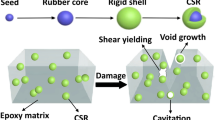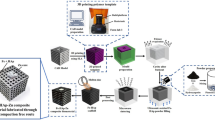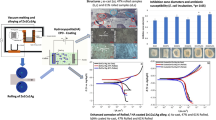Abstract
We fabricated resin composites based on a standard matrix system used for dental restorations incorporating a novel concept microsized filler with passing-through nanopores. The fillers were obtained from anodic porous alumina (APA), after separation from the supporting aluminum substrate and ball milling. Bending tests were carried out on as-cured and artificially aged composites, to determine the material elastic modulus and its strength for the first time. A two-scale modeling was developed; at micro scale, a finite element (FE) model of the representative volume element (RVE) including single APA and surrounding polymer was constructed. The influence of embedded APA length and APA–matrix interaction on the strength was investigated. Then, FE model of the macro-scale RVE containing numerous APA with different orientations based on stochastic modeling was constructed. The output of micro-scale model was used as the input of macro-scale model. The results of simulations allowed to understand better the behavior of the novel composite and interpret the material response deviations from those of common three-phases composites, and to validate the experimental results. The strength of the experimental composite is lower than those of commercial composites used for the same application when as-cured, but is higher after aging.








Similar content being viewed by others
References
Darvell B (2013) Innovation in restorative dental materials: another new age or the end of the line? Future Med Chem 5:1595–1597. https://doi.org/10.4155/fmc.13.131
Darvell BW (2013) Esthetic dentistry. Am J Esthet Dent 3:167–168
Chen M-H (2010) Update on dental nanocomposites. J Dent Res 89:549–560. https://doi.org/10.1177/0022034510363765
Ferracane JL (2011) Resin composite–state of the art. Dent Mater 27:29–38. https://doi.org/10.1016/j.dental.2010.10.020
Ferracane JL, Pfeifer CS, Hilton TJ (2014) Microstructural features of current resin composite materials. Curr Oral Health Rep 1:205–212. https://doi.org/10.1007/s40496-014-0029-4
Habib E, Wang R, Wang Y, Zhu M, Zhu XX (2015) Inorganic fillers for dental resin composites: present and future. ACS Biomater Sci Eng. https://doi.org/10.1021/acsbiomaterials.5b00401
Thorat SB, Diaspro A, Salerno M (2014) In vitro investigation of coupling-agent-free dental restorative composite based on nano-porous alumina fillers. J Dent 42:279–286. https://doi.org/10.1016/j.jdent.2013.12.001
Darvell BW (2009) Materials science for dentistry, 9th edn. Woodhead Publishing, Sawston. https://doi.org/10.1533/9781845696672.163
Sulka GD (2008) Highly ordered anodic porous alumina formation by self-organized anodizing. In: Eftekhari A (ed) Nanostructured materials in electrochemistry. Wiley-VCH Verlag GmbH & Co. KGaA, Weinheim, pp 1–96
Salerno M, Patra N, Losso R, Cingolani R (2009) Increased growth rate of anodic porous alumina by use of ionic liquid as electrolyte additive. Mater Lett 63:1826–1829. https://doi.org/10.1016/j.matlet.2009.05.058
Salerno M, Loria P, Matarazzo G, Tomè F, Diaspro A, Eggenhöffner R (2016) Surface morphology and tooth adhesion of a novel nanostructured dental restorative composite. Materials (Basel) 9:203–210. https://doi.org/10.3390/ma9030203
Thorat S, Diaspro A, Scarpellini A, Povia M, Salerno M (2013) Comparative study of loading of anodic porous alumina with silver nanoparticles using different methods. Materials (Basel) 6:206–216. https://doi.org/10.3390/ma6010206
Salerno M, Giacomelli L, Larosa C (2010) Biomaterials for the programming of cell growth in oral tissues: the possible role of APA. Bioinformation 5:291–293
Toccafondi C, Dante S, Reverberi AP, Salerno M (2015) Biomedical applications of anodic porous alumina. Curr Nanosci 11:572–580
Budarapu PR, Gracie R, Yang SW, Zhuang X, Rabczuk T (2014) Efficient coarse graining in multiscale modeling of fracture. Theor Appl Fract Mech 69:126–143. https://doi.org/10.1016/j.tafmec.2013.12.004
Talebi H, Silani M, Bordas SPA, Kerfriden P, Rabczuk T (2014) A computational library for multiscale modeling of material failure. Comput Mech 53:1047–1071. https://doi.org/10.1007/s00466-013-0948-2
Msekh MA, Cuong NH, Zi G, Areias P, Zhuang X, Rabczuk T (2018) Fracture properties prediction of clay/epoxy nanocomposites with interphase zones using a phase field model. Eng Fract Mech 188:287–299. https://doi.org/10.1016/j.engfracmech.2017.08.002
Hamdia KM, Silani M, Zhuang X, He P, Rabczuk T (2017) Stochastic analysis of the fracture toughness of polymeric nanoparticle composites using polynomial chaos expansions. Int J Fract 206:215–227. https://doi.org/10.1007/s10704-017-0210-6
Rafiee R, Eskandariyun A, Larosa C, Salerno M (2021) Multi-scale modeling of polymeric composites including nanoporous fillers of milled anodic alumina. Arab J Sci Eng. https://doi.org/10.1007/s13369-021-06199-x
Benetti AR, Peutzfeldt A, Lussi A, Flury S (2014) Resin composites: modulus of elasticity and marginal quality. J Dent 42:1185–1192. https://doi.org/10.1016/j.jdent.2014.07.004
El-Safty S, Akhtar R, Silikas N, Watts DC (2012) Nanomechanical properties of dental resin-composites. Dent Mater 28:1292–1300. https://doi.org/10.1016/j.dental.2012.09.007
Randolph LD, Palin WM, Leloup G, Leprince JG (2016) Filler characteristics of modern dental resin composites and their influence on physico-mechanical properties. Dent Mater 32:1586–1599. https://doi.org/10.1016/j.dental.2016.09.034
Czasch P, Ilie N (2013) In vitro comparison of mechanical properties and degree of cure of bulk fill composites. Clin Oral Investig 17:227–235. https://doi.org/10.1007/s00784-012-0702-8
Salerno M, Derchi G, Thorat S, Ceseracciu L, Ruffilli R, Barone AC (2011) Surface morphology and mechanical properties of new-generation flowable resin composites for dental restoration. Dent Mater 27:1221–1228. https://doi.org/10.1016/j.dental.2011.08.596
Cysne AP, Paula A, Fulco P, Guerra ESS, Arakaki FK, Melo DD, Carolina M, Costa B (2017) Accelerated aging effects on carbon fiber/epoxy composites. Compos Part B Eng 110:298–306. https://doi.org/10.1016/j.compositesb.2016.11.004
Cesar PF, Miranda G, Braga RR (2001) Influence of shade and storage time on the flexural strength, flexural modulus, and hardness of composites used for indirect restorations. J Prosthet Dent 86:289–296
Janda R, Latta M (2005) The effects of thermocycling on the flexural strength and flexural modulus of modern resin-based filling materials. Dent Mater 2:1103–1108. https://doi.org/10.1016/j.dental.2005.09.005
Ferracane JL, Berge HX, Condon JR (1998) In vitro aging of dental composites in water—effect of degree of conversion, filler volume, and filler/matrix coupling. J Biomed Mater Res 42(3):465–472. https://doi.org/10.1002/(sici)1097-4636(19981205)42:3%3C465::aid-jbm17%3E3.0.co;2-f
Yilmaz E, Sadeler R (2018) Effect of artificial aging environment and time on mechanical properties of composite materials. J Dent Res Rev 5:111. https://doi.org/10.4103/jdrr.jdrr_50_18
Karimzadeh A, Ayatollahi MR, Shirazi HA (2014) Mechanical properties of a dental nano-composite in moist media determined by nano-scale measurement. Int J Mater Mech Manuf 2:67–72. https://doi.org/10.7763/IJMMM.2014.V2.102
Thorat S, Diaspro A, Salerno M (2013) Effect of alumina reinforcing fillers in BisGMA-based resin composites for dental applications. Adv Mater Lett 4:15–21. https://doi.org/10.5185/amlett.2013.icnano.283
Leprince J, Palin WM, Mullier T, Devaux J, Vreven J, Leloup G (2010) Investigating filler morphology and mechanical properties of new low-shrinkage resin composite types. J Oral Rehabil 37:364–376. https://doi.org/10.1111/j.1365-2842.2010.02066.x
Acknowledgements
AP thanks the State program for scientific research of the Republic of Belarus “Convergence 2025” (tasks 3.03.3 and 2.2.6) for supporting his contribution to this work.
Author information
Authors and Affiliations
Contributions
MS and RR designed the study, for the experimental and modeling part, respectively. AP fabricated and characterized the APA. MS fabricated the composites and characterized them. AG carried out the work for the modeling and simulation part, under the guidance of RR. MS drafted the manuscript. All authors discussed the results and revised the manuscript.
Corresponding authors
Ethics declarations
Conflict of interest
The authors declare no conflicts of interest. No relationships or interests of the manuscript’s authors exist that could potentially influence or bias the submitted work.
Additional information
Publisher's Note
Springer Nature remains neutral with regard to jurisdictional claims in published maps and institutional affiliations.
Supplementary Information
Below is the link to the electronic supplementary material.
Rights and permissions
About this article
Cite this article
Ghorbanhossaini, A., Rafiee, R., Pligovka, A. et al. Dental composites with strength after aging improved by using anodic nanoporous fillers: experimental results, modeling, and simulations. Engineering with Computers 39, 387–398 (2023). https://doi.org/10.1007/s00366-021-01566-6
Received:
Accepted:
Published:
Issue Date:
DOI: https://doi.org/10.1007/s00366-021-01566-6




